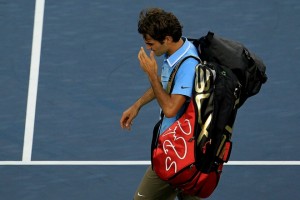A mental mistake that has plagued Roger Federer since his early days of competitive tennis may have cost him a chance to play Rafael Nadal in the 2010 US Open men’s singles final. In one of the most memorable semifinal matches in the history of the US Open, Novak Djokovic prevented Federer from reaching a seventh straight US Open final with a stirring 5-7, 6-1, 5-7, 6-2, 7-5 upset win.

With Djokovic serving at 3-4, 15-30 in the fifth set, Federer had a look at a near sitter backhand as Djokovic’s volley popped up giving Federer a great opportunity for a double-break point opportunity to serve for the match. It appeared, as John McEnroe on CBS television also pointed out, that Federer tried to hit a dramatic around-the-post backhand passing shot, instead of hitting a higher percentage – but less spectacular – forceful backhand that if placed in play, would have, in all likelihood, won him the point. Federer, however, netted the shot, making the score 30-30 rather than 15-40. While Djokovic scrapped his way to hold serve that game – and later saving two match points at 4-5, 15-40 – any slim opportunity in a match determined by such a slim margin is critical. This one point may have caused Federer to lose the match.
Swiss tennis journalist Rene Stauffer in his book ROGER FEDERER: QUEST FOR PERFECTION ($19.95, New Chapter Press, www.RogerFedererBook.com) notes that since Federer was a young player, he always had the flair for making the dramatic shot rather that the necessary shot needed to win the point and match.
Wrote Stauffer in his book, “From his early professional days, Federer was a “show-off” who enjoyed trying to hit spectacular—but low percentage—shots and therefore constantly lost matches that he should have won due to his lack of a conservative game plan. “Back then I wanted to show everybody what I was capable of, the difficult strokes I had mastered,” Federer once admitted. “But at some point it became clear to me that I would get more attention if I were among the top players in the world and if I were to play on the big Centre Courts.” Federer learned to manage the theatrics and began to play more for the scoreboard and not as much the spectators. The willingness to take big risks and his uncompromising aggressiveness gave way to a more calculating tactic that also took the weaknesses of his opponents into consideration. Without this reorientation and change of tactics, Federer never would have become No. 1 in the world.”
The prime example of the Federer “flair for the dramatic” came exactly one year ago on the same court, against the same opponent in the same round of the US Open. Federer hit his legendary between-the-legs shot in the pre-ultimate point in his 7-6 (3), 7-5, 7-5 win over Djokovic in the 2009 US Open semifinals. The shot furthered the Federer legend, spawning commercials for the USTA and the Olympus U.S. Open Series and the now famous Gillette video that has generated millions of views on YOUTUBE of six-time Wimbledon champion hitting a bottle off a person’s head with a serve, ala William Tell. The Federer trick-shot hype was further enhanced when he hit another between-the-legs winner against Brian Dabul in the first round of the US Open this year. The trick shots have been the prevailing theme at the US Open among media, fans and players.
While many have celebrated these two between-the-legs shots during the 2009 and 2010 US Opens, Mary Carillo of CBS also astutely pointed out during Saturday’s CBS US Open coverage the between-the-legs shot that Federer MISSED while match point up on Marat Safin in the semifinals of the 2005 Australian Open. Holding match point by leading two-sets-to-one and 6-5 in the fourth-set tie-break, Federer attempted a “tweener” – that he netted – instead of a higher-percentage shot. Safin won the fourth-set tie-break two points later and went on to win the fifth set 9-7. That missed shot – and the one Saturday against Djokovic – cost Federer a chance at another major title.
